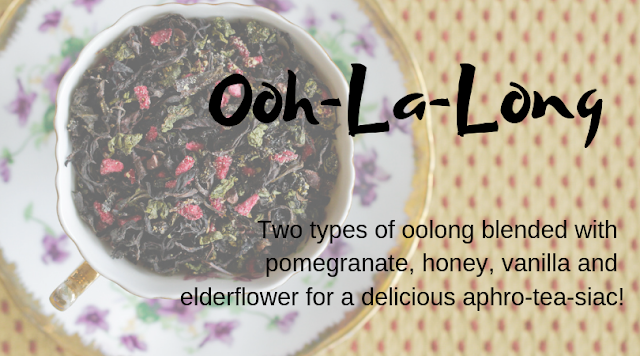Buckle up and prepare to get erotic, because today's blend post dissects a very adult concept: lust. While the rest of our Valentine collection moves along an emotionally chronological path (flirty crush tea to swept-up infatuation tea to sweet and long-lasting true love tea), this blend runs thematically alongside the other three.
Lust is a layered experience, so it follows that a lust-inspired aphro-tea-siac tea should be as well. To that end: oolong. Oolong is designed to be brewed repeatedly, savored at all its myriad levels of complex intensity. First brew's intriguing aroma and green edge will open and relax over infusions two through four, shifting the palate toward notes of orchid and butter. Light oolongs will melt delicately into spring flower and sunshine, while mid-oxidation leaf sasses back with bright bratty notes of peach and cherry bark and dark roasted oolongs bring the serious, passionate intensity of a "must have you now" tryst. Oolongs want to be hot and wet, over and over and over all day. Feeling steamed up? You can see why oolongs were the obvious base for this one.
To really accentuate the nuances and many faces of lust, I opted for two oolongs as the base of this blend. Ti Kwan Yin's floral-milky sweetness balances against Lao Cong's deep charcoal throatiness for an equal embrace of high and low, flower and charcoal, light and dark. A short infusion time will tease and tickle as the green Kwan Yin shows off, but the longer this tea brews the more serious and intense it becomes.
A firm base is vital to a good tea, but so are the myriad accents of flavor and aroma. Lust ranges from musky to dreamy-creamy, so I chose my accent notes accordingly.
Vanilla extract for a familiar heady sweet perfume, both stirring and comfortable.
Honey for an innocent decadent coating that lingers on the tip of the tongue.
Elder flower to bring a meadowy breath of joy and frivolity.
Pomegranate seed as bordello-red homage to the underbelly.
Cacao, complex and rich, to sink into and boost the heart rate.
Pulled together, all of these elements create an evocative tapestry of sex, raw animal nature and sentimental humanity. I won't pretend I didn't have a fantastic time creating this tea, or that I don't have a personal stash in my kitchen for my own enjoyment.
xoxo, Friday

Comments
Post a Comment